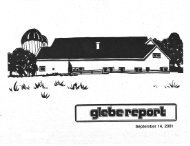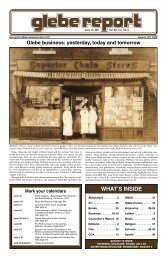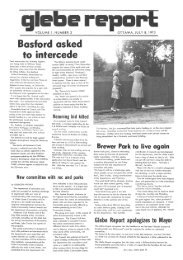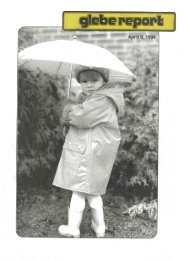April 16, 2010 - Glebe Report
April 16, 2010 - Glebe Report
April 16, 2010 - Glebe Report
Create successful ePaper yourself
Turn your PDF publications into a flip-book with our unique Google optimized e-Paper software.
HEALTH<br />
Keeping drugs out of our<br />
drinking water<br />
by Dr. Dianne Saxe and Jackie Campbell<br />
Two years ago, we told you about the growing problem of pharmaceuticals<br />
in our drinking water. Since then, has government done anything about it?<br />
Ontario Ministry of the Environment survey<br />
In January, the Ministry of the Environment quietly posted new data. Some<br />
258 samples were collected from 17 municipal drinking water systems (half<br />
from source water, and half from treated drinking water). The samples were<br />
analyzed for 46 pharmaceuticals plus Bisphenol A and 27 of them were detected.<br />
(They did not check for the presence of illegal drugs, like cocaine or<br />
marijuana.)<br />
In untreated source waters (rivers, lakes ): the most frequently detected<br />
categories of drugs were: anticonvulsants; lipid-lowering agents; analgesics;<br />
antimicrobials; veterinary-only anti-infectives: and other drugs, such as Bisphenol<br />
A (a plasticizer now banned in baby bottles).<br />
In treated drinking water: the most frequently detected drugs were Carbamazepine<br />
(an anticonvulsant), Gemfibrozil (a lipid-lowering agent), Ibuprofen<br />
(a commonly used fever/pain medication) and Bisphenol A (a notorious plasticizer).<br />
Unfortunately, there are no regulatory standards for safe levels of drugs in<br />
drinking water, and no one knows the effects of lifelong exposure to mixtures<br />
of different drugs. Nor is there any evidence that bottled water is any better;<br />
bottled water is usually made from tap water, or from the same types of source<br />
water that municipalities use.<br />
The good news?<br />
1. Drug levels in drinking water are tiny.<br />
2. Current water treatment plants may not be designed to treat pharmaceuticals,<br />
but they do help. Drug concentrations in finished (treated) drinking water<br />
were usually lower than those in untreated source water.<br />
3. Regulators in both Canada and Australia conclude that one would have to<br />
drink thousands of glasses of water a day to exceed “acceptable” daily intakes<br />
of individual drugs.<br />
Australia has been thinking about how to set safe limits for pharmaceuticals<br />
in drinking water, and has proposed public guidelines. For example, regulators<br />
could divide the lowest daily therapeutic dose by a reasonable safety factor,<br />
which has to protect toddlers and pregnant women. After much discussion,<br />
they propose a safety factor from 1,000 to 10,000. As an example, Australian<br />
guidelines consider the antibiotic Norfloxacin (lowest daily dose 800 mg/<br />
day): applying a safety factor of 1,000 would mean that 0.8 mg (i.e., 800 mcg)<br />
could be ingested each day via (the average) 2 litres of water individuals consume<br />
each day. That translates to a maximum acceptable concentration of 400<br />
mcg/L, well above concentrations that have actually been measured.<br />
I admit, however, that this apparently scientific calculation doesn’t make me<br />
feel much better for the following reasons:<br />
• Drug safety tests never endure for an entire lifetime, and the “lowest<br />
daily therapeutic dose” isn’t calculated with lifetime exposure in mind.<br />
• What if the right safety factor for Norfloxacin ought to be 10,000 or<br />
100,000?<br />
• What if I am from an ethnic group that is particularly sensitive to a particular<br />
drug or group of drugs?<br />
• Lots of drugs have additive or synergistic effects, meaning that exposure<br />
to one can amplify the effect of another. Even grapefruit or various<br />
herbal remedies are known to have this effect.<br />
• Many people are exposed to more than 2 L of water a day, in drinking<br />
and cooking.<br />
• What if the drugs can be absorbed through the skin, i.e. from swimming,<br />
laundry or bathing?<br />
• What if the drugs are also present in consumer products that are made<br />
with water, like shampoo or hand cream? Or in food that has been irrigated<br />
with water containing drugs?<br />
• Some drugs have hormonal effects and can affect the human body at<br />
incredibly tiny concentrations.<br />
• What about fish, and other plants and animals? What are the drugs doing<br />
to them?<br />
I think we need to do something about these drugs in our water supply.<br />
What can we do?<br />
Post-consumer pharmaceutical waste will be regulated as of July 1 in Ontario.<br />
Fortunately, there is one easy thing that can help. Leftover drugs should<br />
never be flushed down toilets or discarded with regular garbage. Consumers<br />
should return unused drugs to their pharmacies for incineration. So far,<br />
returning drugs to pharmacies is voluntary in most of the country; only BC<br />
requires it. Vancouver bans consumers from throwing unused medications into<br />
curbside garbage, which has prompted a huge increase in consumer awareness.<br />
As of July 1, Ontario will also regulate consumers’ unused drugs, and hopes to<br />
collect about 659 tons a year, all at the expense of the drug manufacturers.<br />
Believe it or not, 90 per cent of Ontario pharmacies already accept unused<br />
drugs, and the rest will have to this summer. Every pill bottle returned to a<br />
pharmacy may help to keep something important out of our drinking water. It<br />
is an easy thing to do right.<br />
Dr. Dianne Saxe is an environmental law specialist and Jackie Campbell is<br />
a lawyer and practising pharmacist who can be reached at admin@envirolaw.<br />
com or 4<strong>16</strong>-962-5009. Details and reference material for this article can be<br />
sourced at http:// envirolaw.com. This piece was excerpted from the full-length<br />
article which is available on envirolaw.com.<br />
Paul Dewar, MP/Député Ottawa Centre<br />
Working for you!<br />
Au travail pour vous!<br />
I am pleased to:<br />
• provide assistance with federal agencies<br />
• arrange letters of greetings for special occasions<br />
• answer questions about federal legislation<br />
• listen to your feedback<br />
Je suis heureux de:<br />
• vous aider à traiter avec les organismes fédéraux<br />
• vous écrire des lettres de félicitations pour des<br />
occasions spéciales<br />
• répondre à vos questions sur les lois fédérales<br />
• vous écouter<br />
304-1306 rue Wellington St.<br />
613.946.8682 / dewarp@parl.gc.ca<br />
www.pauldewar.ca<br />
<strong>Glebe</strong> <strong>Report</strong> <strong>April</strong> <strong>16</strong>, <strong>2010</strong> 21

















